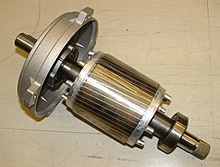
Back دوار قفص سنجابي Arabic Gàbia d'esquirol Catalan Kurzschlussläufer German Jaula de ardilla Spanish Urtxintxa-kaiola Basque موتور قفسسنجابی Persian Häkkikäämitty roottori Finnish かご形三相誘導電動機 Japanese 농형 3상 유도전동기 Korean Kooianker Dutch

A squirrel-cage rotor is the rotating part of the common squirrel-cage induction motor. It consists of a cylinder of steel laminations, with aluminum or copper conductors embedded in its surface. In operation, the non-rotating stator winding is connected to an alternating current power source; the alternating current in the stator produces a rotating magnetic field. The rotor winding has current induced in it by the stator field, like a transformer except that the current in the rotor is varying at the stator field rotation rate minus the physical rotation rate. The interaction of the magnetic fields in the stator and the currents in the rotor produce a torque on the rotor.
By adjusting the shape of the bars in the rotor, the speed-torque characteristics of the motor can be changed, to minimize starting current or to maximize low-speed torque, for example.
Squirrel-cage induction motors are very prevalent in industry, in sizes from below 1 kilowatt (1.3 hp) up to tens of megawatts (tens-of-thousand horsepower). They are simple, rugged, and self-starting, and maintain a reasonably constant speed from light load to full load, set by the frequency of the power supply and the number of poles of the stator winding. Commonly used motors in industry are usually IEC or NEMA standard frame sizes, which are interchangeable between manufacturers. This simplifies application and replacement of these motors.
© MMXXIII Rich X Search. We shall prevail. All rights reserved. Rich X Search